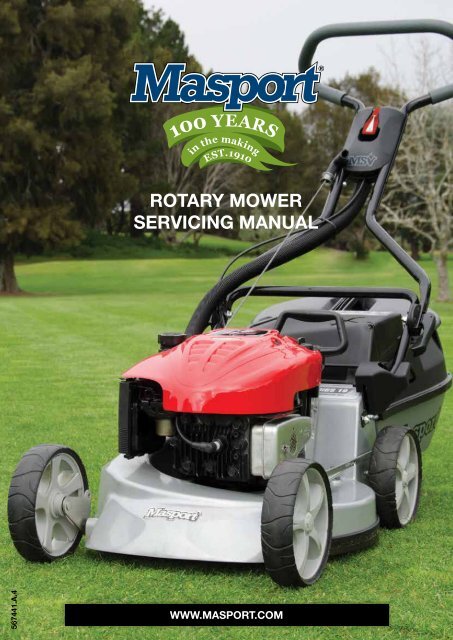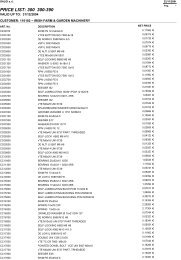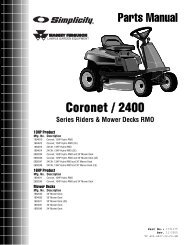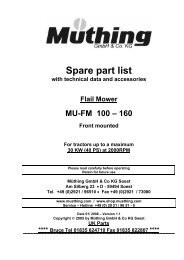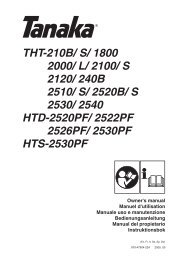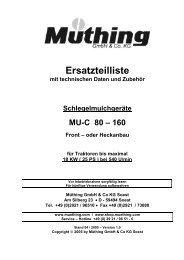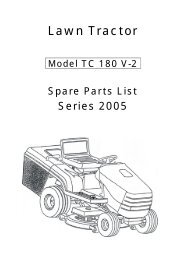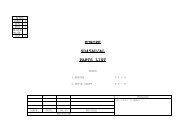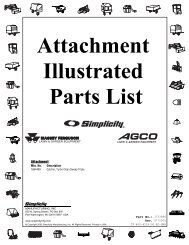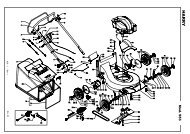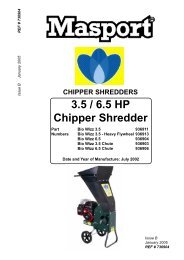Create successful ePaper yourself
Turn your PDF publications into a flip-book with our unique Google optimized e-Paper software.
Drive Clutch Cable Adjustment (All models)1. Confirm that the cable inner wire will move at least 26 mm whenthe SP bail (see page 2) is moved from the clutch disengaged(open) position to the engaged (closed) position against thehandle. Adjust the contour of the bail slightly if necessary toachieve this wire stroke.2. Wheel the mower backwards towards you while graduallyclosing the SP bail, and note the position of the bail when extraresistance to backwards movement indicates that the drive clutchis just engaging. This extra resistance should occur when the SPbail is half way between open and closed.3. If the engagement point is incorrect, adjust it by rotating thethumb-wheel on the anchor block at the top of the cable outersleeve. Rotating the wheel clockwise will move the clutchengagement point nearer to the bail closed position, and anticlockwisewill move it towards the bail open position.4. Confirm that the adjustment is correct by re-testing theengagement point.5. Repeat this adjustment after 150 hours use of the mower or atany time if the mower drive seems to be slipping.IMPORTANT: An incorrectly adjusted clutch cable, or using themower with the SP bail not fully against the handle will causeclutch slippage, gearbox overheating and serious gearboxdamage.5. Re-assemble the thumb-wheel and mounting block onto the topend of the cable. Tip: To prevent the cable from slipping out of itssocket on the gearbox while re-fitting the rear axle assembly, takethe slack out of the wire and keep the outer cable in its socket byfitting a temporary clamp on the wire against the top end of theouter cable.Drive Clutch Cable Replacement (Rear wheel drive models)1. Follow steps 1 to 11 detailed in REMOVING THE REAR AXLEUNIT FROM THE MOWER (see below).2. At the top end of the clutch cable, wind the thumb-wheeladjuster until the thumb-wheel and the thumb-wheel block canbe removed completely from the threaded ferrule on the outercable.6. Re-fit the rear axle assembly onto the mower by following thedismantling steps in the reverse order.7. Hook the ‘Z’ bend at the top of the cable wire into the SP bail,and fasten the thumb-wheel block onto the handle. Fit the newcable ties and remove the temporary clamp from the cable wire.8. Adjust the cable for correct operation as described above inDRIVE CLUTCH CABLE ADJUSTMENT.3. The cable will now be small enough to pass through the aperturein the housing and will then be completely free from the mower.As the cable ties are removed, note their positions so that thenew ones can be fitted exactly in the same positions. This isimportant to allow the handle to fold correctly.4. Pass the top end of the new cable up through the housingaperture. Attach its lower end to the gearbox by hooking thecable spring onto the gearbox clutch lever, dropping the wirethrough its slot and sliding the clutch outer cable into the socketat the end of the slot.Drive Clutch Cable Replacement (Rotarola & front wheel drivemodels)1. Remove the belt cover to gain access to the top of the gearbox.2. Examine the path of the old cable, noting particularly where thecable ties are fitted as this is important to ensure satisfactoryhandle folding.3. Withdraw the screw holding the cable thumb-wheel block to thetop of the handle. This will give enough slack in the cable to allowthe ‘Z’ shaped fitting at the top of the wire to be extracted fromthe lug on the SP bail.4. Working down the cable, cut the cable ties. At the gearbox, pullthe cable outer housing away from the gearbox to disengage itfrom its locating hole.5. Lift the cable wire up out of the slot in the gearbox and swing thewire to the side so that the spring on the end of the cable wirecan be unhooked from the gearbox lever.6. To fit the new cable, reverse the dismantling procedure.7. After engaging the ‘Z’ fitting in the SP bail (take care to fit it fromthe side of the SP bail lug that gives a straight run for the wireinto the cable housing), fasten the thumb-wheel block to thehandle and adjust the clutch action as detailed above.4
Drive Clutch Cable Adjustment for models with the followinggearbox type fitted:• Cone Clutch Transmissions, single and variable speed• Dog Clutch Transmissions, single and variable speedPlease note models with the synchro gearbox fitted do not requiredrive clutch cable adjustment, for more details refer to SynchroClutch Transmissions Gearbox page.1. Confirm that the cable inner wire will move at least 26 mm whenthe SP bail (see page 2) is moved from the clutch disengaged(open) position to the engaged (closed) position against thehandle. Adjust the contour of the bail slightly if necessary toachieve this wire stroke.2. Wheel the mower backward toward you while gradually closingthe SP bail, and note the position of the bail when extraresistance to backward movement indicates that the drive clutchis just engaging. This extra resistance should occur when the SPbail is half way between open and closed.3. If the engagement point is incorrect, adjust it by rotating thethumb-wheel on the anchor block at the top of the cable outersleeve. Rotating the wheel clockwise will move the clutchengagement point nearer to the bail closed position, and anticlockwisewill move it toward the bail open position.4. Confirm that the adjustment is correct by re-testing theengagement point.5. Repeat this adjustment after 150 hours use of the mower or atany time if the mower drive seems to be slipping.Variable Speed Propulsion ControlSome models have an extra feature that allows the travel speed to bevaried independently of the engine speed. They have a control like thisone (illustrated below).movement of the belt idler arm. If they do not match, either the topor the bottom intended speed of travel will be unobtainable. Thismatching is achieved by adjusting the length of the cable outer sleeve.As explained above, the belt will not respond to downward travelspeedchanges unless the engine is running. Do not engage the driveclutch while making these adjustments, but make small changes andthen engage the drive to check the results. A better approach is toremove the gearbox cover on the rear face of the mower housing(3 screws), or the front of the mower in the case of front wheel drivemodels. Then the adjustment can be made and verified withoutengaging the drive clutch at all.Confirm that the outside of the V belt comes out to the full outsidediameter of the gearbox input pulley when the control lever is movedto the ‘SLOW’ position. At the ‘FAST’ end of the range, the belt willbe pulled deep between the two halves of the split pulley. Remember,the engine must be running while moving the control lever.We recommend checking this adjustment after the first 5 hours ofmower use while the new belt is settling in. Subsequently check it onlyif it is apparent that the mower is not achieving full travel speed.The speed variation is achieved by having a ‘split’ V pulley on thegearbox input shaft and an idler on the drive belt. The pulley isspring-loaded to move the pulley halves close together. In the SLOWposition, the pulley acts just as a normal pulley of the same outerdiameter. However, to achieve faster travel speeds, the belt tensionis increased by moving the belt idler, which alters the path the belt isfollowing. This pulls the belt into the gearbox pulley, driving the twohalves of the pulley apart and making it behave as if it were a smallerdiameter, thus increasing the speed of the gearbox input shaft andraising the travel speed.Fitting a New Variable Speed Control CableDO NOT REMOVE THE OLD CABLE BEFORE YOU HAVEPREPARED THE NEW ONE. This will help you to fit the new one inexactly the same position and to hold it there with new cable clipsat the original fixing points. This will ensure that the cable will workcorrectly and that the handle will fold properly.1. Make sure the control lever of the new cable is in the ‘SLOW’position.WARNING: When the idler tension is released, the pulley canreturn to its full diameter only if the belt is moving. The speedcontrol lever should be moved only when the engine is running.Moving the lever to ‘SLOW’ when the engine is stationary willresult in a slack belt giving no propulsion at all. To recoverfrom this situation, move the speed control lever to the ‘FAST’position with the engine running.Variable Speed Propulsion Control AdjustmentIn order to maintain the full range of available speeds, it is necessaryto match the wire travel of the speed adjuster cable to the required5
2. Confirm that the cable length adjuster is in the closed position. Toalter its length, hold the two hexagonal ends and rotate the centrebarrel.3. Keeping the speed control lever upwards, bend the wire at theother end of the cable downwards as shown. The ‘X’ dimensionvaries for different mower models. See below for ‘X’ dimension.MOWER‘X’ (mm)21” AL SPV Ø79 PULLEY 7621” AL SPV Ø68 PULLEY 6521” AL SPV Ø60 PULLEY 6121” ST SPV 8020” AL SPV 5719” AL SPV 1059. Re assemble the idler pulley and belt.10. Adjust the cable length for correct travelling speed as detailedabove.11. Fit the belt cover.Adjusting the Drive Belt (Single speed models)DESCRIPTION: The ‘V’ belt carrying the drive from the engine to thepropulsion gearbox runs between a pulley on the engine crankshaft(directly under the engine) and a pulley on top of the gearbox. The beltruns in a tunnel provided on aluminium models by a belt cover boltedon top of the mower housing, while steel mowers have a welded-inpanel below the housing for the same purpose. In all models exceptthe Rotarola, the gearbox output shaft extends right across themower and it has a pinion mounted on each end. The pinions aredriven by pawls working in slots in the output shaft. While the basiclayout is similar on all rear wheel drive mowers, the addition of extrafeatures like the variable speed drive or the fitting of a chipper tubeincreases the complexity of the belt drive system.Adjusting the belt tension if there is an adjustable idler pulley:Some mowers have ‘fixed’ belt idler pulleys to guide the belt aroundobstructions. These fixed idlers can, in some cases, be moved alonga slot to adjust the belt tension. If it is necessary to tilt the mower foraccess to the idler post fixing nut, it is best to tip the mower on its rearwheels, keeping the spark plug uppermost to avoid spilling oil and fuelinto the air filter, carburetor and muffler. Avoid over-tightening the beltas this can cause unnecessary wear. The longest run of the belt shouldstill be able to be flexed in and out by a total of 6 to 8 mm undermoderate hand pressure.The Rotarola drive belt follows an ‘L’ shaped path above the housingby running over two idler pulleys. The belt tension is adjusted bymoving one idler pulley along its mounting slot. Gain access foradjusting the belt by removing the left hand side cover and the top beltcover. Do not over tighten the belt (see last paragraph).Adjusting the belt tension if there is no adjustable idler pulley:In the case of the basic layout (i.e. no variable speed or chipper tube)the belt runs directly between the two pulleys, and the belt tensionadjustment is achieved by rotating the gearbox around its output shaft.4. Make the second bend as shown, and then cut off the excesswire.To do this, it is necessary to slacken the gearbox clamp screw (shownabove). In some cases access to the screw can be improved byremoving the left rear wheel. If you do this, note specially the positionsand numbers of any spacing washers on the stub axle and behind theplastic dust cover so that they can be replaced correctly.5. Remove the belt cover from the top of the mower housing.6. Lay the cable on the mower alongside the old one. Remove theold control box and fit the new one. Starting at the top, cut off theold cable ties and fit new ones around the appropriate adjoiningcables and fastening points. Correct positioning is important toachieve satisfactory handle folding.7. Cut the retaining lugs on the plastic fitting at the bottom of the oldcable and withdraw it from the cable bracket. Fit the new cable inits place. Just push it into the mounting hole.8. Fit the bend of the wire into the hole in the idler pulley mountingplate. This will require dismantling of the idler pulley as describedin Step 6 of REPLACING DRIVE BELTS ON VARIABLE SPEEDMODELS below.Having slackened the gearbox clamp screw, rotate the gearboxaround its output shaft to take up the slack in the belt. Tighten theclamp screw after making this adjustment. Avoid over-tightening thebelt as this can cause unnecessary wear. The longest run of the beltshould still be able to be flexed in and out by a total of 6 to 8 mmunder moderate hand pressure.Adjusting the Drive Belt (Variable speed models)As explained above (see VARIABLE SPEED PROPULSIONCONTROL), the belt tension is automatically provided by the action ofthe spring-loaded split gearbox pulley. However it is important that thetravel of the belt idler matches the starting and finishing points of thevariable speed control lever travel. This is achieved by adjusting thelength of the variable speed control.6
Replacing Drive Belts on Rear WheelDrive Models (NOT Rotarola)Important: All ‘V’ belts are not created equal! It is essential forcorrect fit and for satisfactory service life, that only the beltsupplied by the mower manufacturer be used as a replacement.Other belts, even though they have the same length markings,may not fit correctly, and they may have a greatly reducedservice life because of their unsuitable internal construction.Preparation (Single and Variable Speed models)All fuel and oil must be drained from the mower before commencingthis procedure as the mower will be tipped over. This will avoid the riskof fuel and oil reaching vulnerable parts of the mower. In any case, thiscould be a sensible time to make an oil change.8. Slacken off the set screw which clamps the gearbox mountagainst the side wall of the mower housing. Tap the left end of therear axle gently to move the gearbox to the right just enough toallow the ‘V’ belt to pass between the housing and the gearboxpulley.SEE THE NOTE ON ‘POSITIONAL DESCRIPTIONS’ AT THEBEGINNING OF THESE INSTRUCTIONS.(PAGE 2)Replacing Drive Belts on Single Speed models.(Except Rotarola and front wheel drive models)1. Tie the flap at the rear of the grass discharge tunnel in the fullyopen position, using the handle as an anchor point.2. Remove the gearbox cover plate from the rear wall of the mowerhousing. (3 screws)3. If there is a cover over the ‘V’ belt above the housing, remove it.(2 nuts, 2 flat washers)4. Tip the mower on its right hand side, remove the blade boltfrom the lower end of the crankshaft, and lift the blade or bladeassembly clear of the mower. It should not be necessary to pullthe blade driver off the crankshaft.9. Unless the mower has a chipper tube, it should be possible tolift the old ‘V’ belt clear and fit the new one in place. If it has achipper tube, remove it by unscrewing the two mounting screwsholding the tube against the sloping face of the housing. Accessto these screws is through the gearbox compartment. If themower has a steel housing and it has a fixed idler pulley, it will benecessary to remove the fixed idler completely to release the oldbelt.5. Examine the mower to establish the correct routing for the newbelt. If there is a fixed idler pulley post, slacken its fastening nutand slide it to slacken the belt as far as possible.10. Fit the new belt, re-fit the chipper tube (if any), and replace thefixed idler if it was removed at step 9. Tip: It will be easier to fit thefixed idler before fitting the chipper tube.6. Remove the left rear wheel hub cap, undo the wheel retaining nutand pull off the washer, the wheel and the plastic dust cover. Tip:Be careful to note the positions of any washers on the axle (bothin front of and behind the dust cover) so they can be replacedcorrectly.7. Check the distance between the gearbox pulley and the left handside of the housing to see whether there is sufficient room for thenew belt to pass through. If not, it will be necessary to move thegearbox slightly to the right to provide access. To do this, removethe split plastic sleeve from the rear axle to gain access to thecirclip against the right hand rear axle bearing. Lift this circlip outof its groove and slide it along the rear axle toward the gearboxabout 10 mm. Do NOT overstretch the circlip.7
FIXED IDLER PULLEY ASSEMBLY6. Remove the fastening nut from the bottom of the idler pulley studand withdraw the stud. Take particular note of the positions of allspacers and washers, and identify the hole in which the stud wasmounted. Some housings have more than one hole in this generalarea, and it is vital to use the correct one. NOTE: On somemodels it will be necessary to at least partially remove the enginemounting bolts so the engine can be lifted sufficiently to allowremoval of the idler pulley stud.1. Gently tap the gearbox toward the left side of the housing untilthere is room to re-fit the circlip against the right rear axle bearing.Do NOT overstretch the circlip!2. Re-fit the split plastic sleeve on the rear axle.3. Rotate the gearbox around the rear axle in a clockwise direction(as viewed from the left hand side of the mower) to tension thebelt and lock the box in position by tightening the gearbox clampscrew. Alternatively, if there is a fixed idler post, clamp the gearboxin the position that best lines up its pulley with the run of the beltand move the idler pulley post along its slot to set the belt tensioncorrectly. Then fasten the post in this position.4. Replace the wheel and plastic dust cover, placing the axlewashers in front of, and behind the cover as they were originally.Fit the wheel retaining washer and nut and assemble the hub caponto the wheel.5. Re-fit the belt cover (if any) and the gearbox cover plate and untiethe grass discharge flap.6. Re-assemble the blade system.7. Turn the mower upright, add oil and fuel and test run.7. There should now be enough slack in the belt to allow it to bemoved clear of the crankshaft pulley and the gearbox pulley.NOTE. In some cases there may be insufficient room betweenthe gearbox pulley and the side of the housing to allow the belt topass through. If this is the case, follow Steps 8, 9 and 10 below.8. Remove the left rear wheel hub cap, undo the wheel retaining nutand pull off the washer, the wheel and the plastic dust cover. Tip:Be careful to note the positions of any washers on the axle (bothin front of and behind the dust cover) so they can be replacedcorrectly.9. In some cases it will be necessary to move the gearbox slightlyto the right to provide room for the belt to pass between thepulley and the housing. To do this, remove the split plastic sleevefrom the rear axle to gain access to the circlip against the righthand rear axle bearing. Lift this circlip out of its groove and slideit along the rear axle toward the gearbox about 10 mm. Do NOToverstretch the circlip.Replacing Drive Belts on Variable Speed modelsSee the note on PREPARATION above.1. Tie the flap at the rear of the grass discharge tunnel in the fullyopen position, using the handle as an anchor point.2. Remove the gearbox cover plate from the rear wall of the mowerhousing. (3 screws)3. If there is a cover over the ‘V’ belt above the housing, remove it.(2 nuts, 2 flat washers)4. Tip the mower on its right hand side, remove the blade boltfrom the lower end of the crankshaft, and lift the blade or bladeassembly clear of the mower. It is not necessary to pull the bladedriver off the crankshaft.5. Look carefully at the position of the old belt, particularly whereit passes through the idler pulleys mounted on the carrier plate.Note that one pulley is flat to contact the outside of the ‘V’ belt,while the other has a ‘V’ to engage with the ‘V’ of the belt in theusual way. Move the lever of the variable speed control fully intothe ‘SLOW’ position.10. Slacken off the set screw which clamps the gearbox mountagainst the side wall of the mower housing. Tap the left end of therear axle gently to move the gearbox to the right just enough toallow the ‘V’ belt to pass between the housing and the gearboxpulley.11. If the mower has a chipper tube, this will prevent removal of thebelt. Release the chipper tube by unscrewing the two mountingscrews holding it against the sloping face of the housing. Accessto these screws is through the gearbox compartment.8
22. Re-fit the belt cover (if any) and untie the grass discharge flap.23. Re-assemble the blade system.24. Turn the mower upright, add oil and fuel and test run.25. Adjust the variable speed cable length as described in VARIABLESPEED PROPULSION CONTROL ADJUSTMENT above.26. Re fit the gearbox cover plate.Replacing Drive Belts on Roller DriveModels12. Now that the belt is slack it can be removed from the enginepulley. The carrier plate can now be unhooked from the end ofthe speed control cable if desired for easier access. Note verycarefully the correct position for the new belt as it runs betweenthe flat pulley and the ‘V’ pulley of the idler carrier plate assembly.13. Check the condition of the ball race in each pulley and replace ifnecessary. The bearings are sealed and cannot be serviced.14. Fit the new belt in position over the crankshaft and gearboxpulleys. To give a slacker belt to assist fitting the idler assembly,pull firmly on the belt to pull it deep into the split gearbox pulley.15. With the speed control lever in the slow position, hook the carrierplate onto the control cable (if it has been removed). Assemble thevarious washers and spacers onto the idler pulley stud, keepingthe belt between the pulleys, and fit the stud onto the housing inthe correct hole. Fit the idler pulley stud retaining washer and locknut and tighten. With the stud firmly locked in place, the carrierplate must be able to pivot easily in response to speed controllever movements.1. Remove the blade retaining bolt from the engine crankshaft andlift off the blade assembly. There is no need to remove the bladedriver assembly from the crankshaft. Do not tip the mower onits side to do this without first draining the fuel and oil from theengine.2. Remove the left hand side cover and the top belt cover.3. Remove the adjustable idler (the one with a ‘V’ groove) bywithdrawing its mounting post. Take great care to note thecorrect positions for the various spacers and washers onthe post so that they can be re-assembled correctly.4. To get sufficient room to withdraw the belt from the gearbox pulleyit will be necessary to lift the gearbox slightly. To gain access tothe gearbox mount assembly fasteners, remove the cover panelon the rear near-vertical face of the housing (3 screws).5. The screws holding the gearbox mount can now be reached fromthe compartment behind the cover panel.6. If the gearbox can then not be lifted sufficiently to pass the ‘V’ beltthrough, more room can be made by either removing the chaintensioner on the upper chain, or by disconnecting the joining linkof the chain.7. The belt can now be disengaged from the engine pulley andremoved completely.8. Fit the new belt in position, replace the gearbox mount fastenings,re-fit the rear cover panel, re-connect the chain (or re-fit the chainconnector), fit and adjust the belt idler pulley and replace theblade assembly and blade centre bolt. (Torque 45-50 Nm.)9. Re-fit the top cover and the left hand side cover.16. If the gearbox has been moved sideways as in Steps 8, 9 and 10,move it back to its correct position by following Steps 17 and 18.17. Gently tap the gearbox toward the left side of the housing untilthere is room to re-fit the circlip against the right rear axle bearing.Do NOT overstretch the circlip!18. Re-fit the split plastic sleeve.19. Rotate the gearbox around the rear axle to align the gearboxpulley with the run of the belt and lock the box in position bytightening the gearbox clamp screw.20. Replace the chipper tube.21. Replace the wheel and plastic dust cover, placing the axlewashers where they were originally, fit the wheel retaining washerand nut and assemble the hub cap on the wheel.SERVICING CHAINS ON ROLLER DRIVE MODELSRoller drive mowers have two chains. The primary chain is easy toaccess for lubrication and adjusting as it is exposed to view when theleft side cover is removed. It has a curved plastic block or an idler rollerwhich can be moved into the bottom run of the chain to take out anychain slackness. Clamp the block at an angle that gives a smooth runonand run-off for the chain.9
Replacing Drive Belts on Front WheelDrive ModelsThe secondary chain is inside a small cover which sits against the sideplate of the rear roller frame assembly. Recommended service timesare 25 hours for the primary chain and 100 hours for the secondaryone.SECONDARY CHAIN ACCESS1. Remove the left hand side cover.2. Remove the primary chain adjusting block or idler roller, or at leastslacken it off until it is well clear of the chain.3. Remove the connecting link of the primary chain so that the chaincan be taken off. If you prefer not to remove the connecting link,remove the circlip holding the upper sprocket. Then pull the topsprocket off as you remove the lower sprocket in Step 4.4. Remove the circlip and washer that retain the lower sprocket ofthe primary chain, and pull the sprocket off.5. Remove the three screws holding the secondary chain cover andlift it clear.6. Apply a generous coating of grease to the chain, clean out anydebris from the inside of the cover and replace it.SINGLE SPEED MODELS1. Remove the blade retaining bolt from the engine crankshaft andlift off the blade assembly. There is no need to remove the bladedriver assembly from the crankshaft. Do not tip the mower onits side to do this without first draining the fuel and oil from theengine.2. Remove the front plastic cowl by extracting two mounting screwsfrom underneath, and two mounting screws from above.3. The belt tension is adjusted by rotating the gearbox around itsoutput shaft and the box is held in the desired angular position byan anchor screw. Remove this anchor screw to allow the top ofthe gearbox to move back toward the engine as far as possible.This should allow the belt to be removed from the two pulleys andwithdrawn. If this does not give enough slack in the belt, slackenall three engine mounting bolts and remove the two on the rightof the mower. The engine can then pivot around the other bolt toslacken the belt. Fit the new belt and replace the engine bolts (ifnecessary) and the gearbox anchor screw. Adjust the belt tension(not too tight) and tighten the anchor screw. Re-fit the front cowland blade assembly. Blade centre bolt Torque 45-50 Nm.VARIABLE SPEED MODELS1. Remove the blade retaining bolt from the engine crankshaft andlift off the blade assembly. There is no need to remove the bladedriver assembly from the crankshaft. Do not tip the mower onits side to do this without first draining the fuel and oil from theengine.2. Remove the front plastic cowl by extracting two mounting screwsfrom underneath, and two mounting screws from above.3. Remove the post on which the idler pulley carrier plate pivots,noting carefully the positions of spacers and washers so that theycan be re-assembled correctly. Note exactly where the belt fitsaround the idlers.4. Remove the belt from the two pulleys.5. Fit the new belt and re-assemble the idler pulleys and the carrierpost.6. Replace the blade assembly and the blade centre bolt. Bladecentre bolt Torque 45-50 Nm.7. Crank the engine by hand (Spark plug lead OFF) to settle the beltcorrectly in the split pulley of the gearbox and adjust the variablespeed cable, if necessary, as described in VARIABLE SPEEDPROPULSION CONTROL ADJUSTMENT above.8. Re-fit the front cowl.Replacing Drive Belts on SynchroClutch Transmissions GearboxDrive Clutch Cable Adjustment – This type of gearbox does not requirethe cable adjustment.Adjusting the Drive Belt– This type of gearbox does not require thedrive belt adjustment, the correct belt tension is achieved with thecorrect length of the belt and the tensioning spring.7. Re-assemble the parts in the reverse order of dis-assembly. Takecare when fitting the primary chain sprockets that the long boss ofthe top sprocket goes on the inside, and the larger diameter bossof the lower sprocket also goes on the inside. Take care not todislodge the key when fitting the top sprocket.REPLACING DRIVE BELTPreparationAll fuel and oil must be drained from the mower before commencingthis procedure as the mower will be tipped over. This will avoid the riskof fuel and oil reaching vulnerable parts of the mower. In any case, thiscould be a sensible time to make an oil change1. Tie the flap at the rear of the grass discharge tunnel in the fullyopen position, using the handle as an anchor point.2. Remove the gearbox cover plate from the rear wall of the mowerhousing. (3 screws)3. Remove the cover belt10
4. Tip the mower on its right hand side, remove the blade boltfrom the lower end of the crankshaft, and lift the blade or bladeassembly clear of the mower. It should not be necessary to pullthe blade driver off the crankshaft.Replacing Return Spring on VariableSpeed Models1. Use pliers to grab end of spring on post5. Unhook the tensioning spring , slacken off the set screws whichclamp the gearbox mounting bracket –stopper against the sidewall of the mower housing.2. Pull end of spring over post to remove springTensioningspringMounting bracketstopper6. Rotate the gearbox around the rear axle to loosen the belt,remove the old ‘V’ belt and fit the new one in. Re-fit the mountingbracket – stopper, adjust to maintain a gap between the mountingbracket-stopper and gearbox housing 3mm maximum.3. Replace by inserting open end of spring through hole in lever andusing pliers to hold other end of spring and pull to lever over post.11
Replacing Gearbox Pulley on VariableSpeed Models1. Drive out spring dowel at bottom of assembly and removeassembly from shaftSlow Down/Speed Up Kit InstallationInstructionsAll fuel and oil should be drained from the mower before commencingthis procedure as the mower will be tipped over. This will avoid the riskof fuel and oil reaching vulnerable parts of the mower.1. Remove the gearbox cover plate from the rear of the mowerhousing (see photo below), and the cover over the ‘V’ belt abovethe housing (where applicable).Photo showsgearbox cover plateremoved to revealthe drive belt.2. Tip the mower on its right side and remove the blade and driverassembly from the crankshaft. You may require a puller to dothis. If so, take care not to damage the crankshaft. Or lose theWoodruff key if it comes off with the driver assembly.2. With new assembly, drive spring dowel into assembly but do notgo into the bore. Slide the assembly onto the shaft and line upthe pin with the hole in the shaft.3. Slacken the gearbox clamp screw (shown below with left rearwheel removed) and rotate the gearbox around its output shaft toloosen the ‘V’ belt.4. Loosen the M8 grub screw on the engine pulley and remove thepulley from the crankshaft, again using a puller if necessary. The‘V’ belt can now also be removed.3. Slide the assembly as far as it will go, keeping the pin and hole inalignment. Tap the pin until it enters the hole then hit pin all theway in.5. Fit the replacement pulley and drive belt supplied in the speed kit.6. In some speed kits there are pulley spacers provided. If the pulleybeing fitted is shorter than the one being removed, these spacerscan be fitted to make up the difference.7. Reassembly of the driver, blade carrier, blade, ‘V’ belt etc is thereverse of the above procedure.8. Tension the ‘V’ belt by rotating the gearbox around its output shaftto take up the slack. Tighten the clamp screw (shown in item 2)after making this adjustment. Avoid over-tightening the ‘V’ belt asthis can cause unnecessary wear. The longest run of the ‘V’ beltshould still be able to be flexed in and out by a total of 6 to 8 mmunder moderate hand pressure.9. Refit the gearbox cover and ‘V’ belt cover (where applicable). Priorto running, ensure the blade is tightened to the correct torque andthe engine is refilled with engine oil.12
Rear Axle Unit - Rear Wheel DriveModelsDESCRIPTIONAll rear wheel drive mower models have a similar construction,although there are some variations in the components. The outputshaft of the gearbox has a slot at each end to accept sliding pawlswhose ends engage with the three-lobed ramps inside the piniongears. The sliding pawls oscillate back and forth inside the pinions sothe pinion can rotate freely on the shaft in one direction. But rotationin the opposite direction is prevented by the pawls engaging on thesquare faces of the pinion ramps. This engagement transmits the driveto the wheel gears. The action of ‘free-wheeling’ in one direction allowsthe mower to be pushed forward, and to be steered around corners.When the gearbox clutch is engaged, the output shaft rotates thepinions to drive the mower forward. Note that the pinion gears musthave interior ramps of opposite hand, one for each side of the mower.The gears carry the mark ‘RH’ or ‘LH’ inside, adjacent to the ramp,to show whether they are for the Right Hand or Left Hand side of themower. Remember, right and left are as seen by the operator whenstanding at the handle.While the same pawl can be used on either side of the mower, it MUSTbe installed in the slot so that the rounded corners will run smoothly upthe ramps and the square corners will give positive engagement withthe square faces of the pinion ramps.The pinion gear engages with a larger wheel gear, so the wheel axleis parallel to the gearbox output shaft but some distance from it. Thuswhen the rear axle assembly is rotated about the axis of the gearboxoutput shaft, the wheel axle will travel in a circle some distance awayfrom it. This movement of the wheel axle is used to raise and lower theback of the lawnmower. A connecting rod to the front of the mowermoves a similarly offset wheel axle assembly about its rotation point,raising and lowering the front wheels also.MODIFIED PINIONS AND GEARSA manufacturing improvement was made in May 2010. This was achange to a larger tooth profile on the pinions and gears. The originalpinions had 16 teeth and the matching gears had 60 teeth. Now thepinions have 12 teeth and the gears have 45 teeth. Old style pinionsand gears cannot be mixed with the new ones. See the illustrationabove.As the gear ratio is unchanged, and the shaft centre distance is alsounchanged, it would be possible to use an old set on one side ofa mower and a new set on the other, but we recommend fitting acomplete set if any of the old pinions or gears need replacing. Thepawls are unchanged. If you are replacing an old gear with a spacingshoulder behind it, fit spacer No 569479 behind the new gear to bringthe teeth into correct alignment with the pinion.CORRECT PAWL, PINION AND CAP POSITIONSA spring-loaded height adjusting lever mounted on the rear axleassembly permits the mower height to be raised and lowered, andthe lever drops into a notch in the quadrant to hold the mower atthe desired cutting height. A counterbalance spring attached to theconnecting rod takes some of the mower weight to facilitate raisingand lowering the mower.The rear axle assembly has a plate at each end carrying a wheel stubaxle on the outside, and a bearing sleeve on the inside. The inside ofthe bearing sleeve provides a housing for the sealed ballrace of thegearbox output shaft, while the outside of the sleeve carries the plasticpivot bushes on which the axle assembly rotates as the cutting heightis altered.There are two different methods for mounting the rear axle assemblyto the mower housing. In most aluminium housings there is a partcylindrical seat provided for the plastic pivot bushes, and they areheld in place by saddles screwed edgewise into the wall of thehousing. Steel housings, on the other hand, use flanged steel retainercups which fit over the pivot bushes and fit against the outer faces ofthe housing. The cups have threaded inserts for set screws passingthrough the housing wall to clamp the cups in place. Somealuminium housings use the flanged steel cups instead of saddles.(See Step 7 of REMOVING THE REAR AXLE UNIT FROM REARWHEEL DRIVE MOWERS).REMOVING REAR AXLE UNITS FROM REAR WHEEL DRIVEMOWERSPreparation (All models)We strongly advise that all fuel and oil be drained from the mowerbefore commencing this procedure as the mower will be tipped over.This will avoid the risk of fuel and oil reaching vulnerable parts ofthe mower. In any case, this could be a sensible time to make an oilchange.SEE THE NOTE ON ‘POSITIONAL DESCRIPTIONS’ ON PAGE 2.1. Disconnect the counterbalance spring fitted between theconnecting rod and the housing. Take care, as this spring is verystrong. To minimize the spring tension, set the cutting height to itshighest position. Unhook the spring from the housing by passinga strong wire loop around the front hook of the spring, just abovethe housing. With the wire formed into a closed loop, a suitablehandle through the loop will allow the front hook of the spring tobe pulled forward and out of the hole in the housing. Once clearof the housing, the tension on the spring can be slowly releaseduntil it is safe to remove the wire loop.13
STEEL CUP TYPE2. Remove the screw holding the clutch cable thumb-wheel blockat the top of the handle. This will allow the wire to go slack. The‘Z’ bend at the top of the clutch cable can then be disconnectedfrom the SP bail.3. Turn the mower completely upside down.4. While it is possible to remove the axle assembly with the wheelsattached, it is usually easier to remove them for ease of access.To remove the wheels, lever off the hub caps, remove the retainingnuts and washers and withdraw the wheels. Remove the plasticdust covers from behind the wheels, noting the positions andnumbers of spacing washers each side of the covers for correctre-assembly. NOTE ALSO THAT THESE COVERS ARE NOTIDENTICAL. The left hand cover has an extra hole for clearanceon the connecting rod fastener.5. Remove the gearbox cover plate on the rear face of the mowerhousing.6. Remove the cotter pin or push-on clip that secures theconnecting rod to the side plate of the rear axle assembly anddisconnect the rod from the assembly. Alternatively, if there isinsufficient room between the body and the rear side plate towithdraw the connecting rod, disconnect the rod at the front ofthe mower instead. In this case, the rod can then remain attachedto the rear axle assembly when it is removed from the mower.8. Remove the gearbox clamp screw and the two screws at eachside of the mower that hold the axle assembly to the mower. Toget easier access to the fixing screws adjacent to the gearbox,remove the pinion and pawl on the left side of the mower, andthen move the circlip (the one which is against the right shaftball race) along the shaft toward the gearbox. This will allow thegearbox to move a little to the right. Take care not to over-stretchthe circlip, and remember ‘right’ and ‘left’ refer to the mowerwhen it is the right way up, as seen by the operator standing atthe handle.9. There should be enough movement now available to slip the ‘V’belt off the gearbox pulley.10. The whole rear axle assembly can now be removed from thehousing. Tip: The height adjuster lever will thrust the assembly toone side. Keep this in mind while withdrawing the assembly.11. After moving the assembly a short distance, further movementwill be prevented by the clutch operating cable attached to thegearbox. To disconnect the cable, pull the outer sleeve out ofits socket on the gearbox, lift the cable wire up through the slot,swing the cable clear of the gearbox and unhook the cable springfrom the clutch operating lever on the gearbox.7. Examine the mower to determine whether the axle assembly isheld in place by saddle clamps (screws into the housing walls)or flanged steel cups (screws through the housing walls). Tip:Sometimes access to the screws can be improved by moving theaxle to a different cutting height.12. The rear axle assembly can now be lifted clear.SADDLE CLAMP TYPEDISMANTLING THE REAR AXLE UNITThis is necessary only when replacing a gearbox, shaft bearings orcirclips on the gearbox output shaft, pivot bushes or flanged steelcups (some models only).1. If the wheels and dust covers have not been removed, removethem now, noting the positions and numbers of spacing washersfor the dust covers to ensure correct re-assembly. Also removethe circlip, washer and pinion from each end of the shaft.Withdraw the two pawls, and extract the plastic pinion capdirectly behind each pinion using long-nosed pliers. When reassembling,note that this cap has a larger diameter shoulder onone side than the other. The larger diameter shoulder fits against14
the pinion, while the smaller one goes against the bearing. SeePAWL, PINION AND CAP POSITIONS above.2. Remove the split plastic axle sleeve.3. Working on the inside of the assembly now, ease the circlip onthe right end of the shaft (the long one) which is against the rightshaft bearing out of its slot and slide it along the shaft toward thegearbox. Move it about half way to the gearbox, taking great carenot to over-stress and stretch the circlip.4. If the shaft is not perfectly clean between the right bearing and thenew circlip position, clean it with emery tape so the bearing canslide along easily.5. Gently tap the right hand axle bearing out of its housing towardthe gearbox, then slide the bearing up to the circlip. Use a squareended pin punch against either the centre ring of the bearing orthe outer ring. Do NOT punch against the plastic bearing seal asthis will destroy the bearing.NOTE: Assemblies using saddle clamps do not have the steel cups.The saddle clamps are fitted over the plastic pivot bushes after theaxle unit is positioned in the mower housing.Notes on Flanged Steel Retaining CupsThe cups fit against the outside of the housing with the cup rims facingoutward and fitting against the shoulders of the plastic pivot bushes.The mounting holes on the cups are offset from the cup centerline.The offset brings the axle closer to the ground than it would be if thecup and holes were in line. When re-assembling, take care that theoffset is in the correct direction, as it is sometimes not possible torotate the cups half a turn once the gearbox has been installed in theaxle assembly. The fixing screws for the cups are installed from insidethe housing and pass through the housing into the threaded mountingholes on the cups.6. While supporting the right end of the shaft centrally in the emptybearing housing, gently tap the left bearing out of its housing. Thiswill move the gearbox to the right.7. Once the left bearing is clear of its housing, the whole gearboxcan be moved to the right until the left (short) end of the outputshaft can be moved clear of the left bearing housing. The rightend of the shaft can then be withdrawn from the right housing.The gearbox will now be completely free from the axle assembly. Ifthe assembly is the type fastened to the housing by flanged steelcups, these will be hanging on the pivot bushes. Take note of theirpositions so they can be re-fitted correctly later.RE-ASSEMBLING THE AXLE UNITFollow the dismantling instructions in the reverse order. If your axleassembly has flanged steel cups, it can be helpful to leave the fittingof the pinions and pawls until after the unit has been mounted in thehousing as this will allow you to move the gearbox toward the centreof the mower as described in Step 8 of DISMANTLING THE REARAXLE UNIT to provide more room to reach the fastening screws.15
Removing Front Axles(All Types except Front Drive)The front axle and its bushes are held in place in one of two ways.Aluminium housings use a flat retaining plate against the plastic axlebush, with a set screw holding the plate in place. The set screw fitsinto a tapped hole in the casting. Steel bodied mowers have a springclip with a hook at each end. The clip bears directly on the axleand the hooks engage in holes in the wall of the housing or the axlemounting bracket in the case of some ‘Utility’ models.Remove the axle by withdrawing the retainer screw or unhooking the‘W’ clip by pressing down with a screwdriver as appropriate. Afterreleasing the first hook, swing the clip clear of the axle and unhookthe second hook from the housing. If you want to remove the axleassembly entirely from the mower, you may find it necessary todisconnect the connecting rod first.New plastic bushes can be fitted by springing them over the axle.5. Move the height of cut lever to the highest cut position andunhook the counterbalance spring from the connecting rod.Working from the rear of the mower, use a wire loop around therear hook of the spring to lift it from the slot in the connecting rodand release the tension slowly.6. Turn the mower completely upside down and disconnect theconnecting rod from the rear roller assembly.7. On 18” models, remove the two pivot bar caps (2 screws each)located one at each side of the mower. Access is gained in ahorizontal direction at each side of the roller.8. On 21” models, remove the two pivot bar retaining plates (1 screweach) located one at each side of the mower. Access is gained ina vertical direction.9. The entire rear roller unit should now lift clear of the mower.Removing Rear Roller UnitsPreparationAll fuel and oil must be drained from the mower before commencingthis procedure as the mower will be tipped upside down. This willavoid the risk of fuel and oil reaching vulnerable parts of the mower. Inany case, this could be a sensible time to make an oil change.SEE THE NOTE ON ‘POSITIONAL DESCRIPTIONS’ ON PAGE 2.1. Remove the left hand side cover.2. Remove the primary chain adjusting block, or at least slacken it offuntil it is well clear of the chain.3. Remove the connecting link of the primary chain so that the chaincan be taken off. If you prefer not to remove the connecting link,remove the circlip holding the upper sprocket. Then pull the topsprocket off as you remove the lower sprocket in Step 4.4. Remove the circlip and washer holding the lower sprocket of theprimary chain, and pull the sprocket off.DISMANTLING THE REAR ROLLER UNIT1. Remove the secondary chain cover (3 screws).2. Using a pin punch, drive out the tension pin that fixes the rollersprocket to the roller shaft.3. Pull the two sprockets from the rear roller assemblysimultaneously, bringing with them the secondary chain.4. Remove the set screw and washer from the centre of the righthand end of the roller shaft.5. Ease both the roller shaft bearings out of the side plates of theroller frame.16
7. Remove the gearbox clamp screw and the two screws at eachside of the mower that hold the axle assembly to the mountingbrackets.8. There should be enough movement now available to slip the ‘V’belt off the gearbox pulley.9. The whole front drive unit can now be removed from the housing.6. Move the roller first to the left until the right hand end of the shaftcan be moved out of the bearing housing and clear of the rollerframe. The left end of the roller shaft can then be moved out of itsbearing housing and the roller is completely clear of the frame. Itis not necessary to remove the roller from the frame to replace adamaged bearing. It can simply be fitted from outside the frame.DISMANTLING THE FRONT DRIVE UNITThis procedure is virtually the same as DISMANTLING THE REARAXLE UNIT. The only difference is that the gearbox output shafts areabout the same length, so it is not as easy to distinguish left from rightshafts. The determining feature is that the gearbox anchor bracket is atthe rear of the gearbox. Follow the instructions for the rear wheel driveaxle unit to remove the gearbox from the axle assemblyBladesIMPORTANT. Always use genuine <strong>Masport</strong> replacement bladesand mounting parts to ensure safety and proper performance.Before servicing any blade, remove the spark plug wire andposition it so it cannot accidentally contact the spark plug.Tip the mower back on its rear wheels, keeping the spark pluguppermost to avoid oil entering the engine and air filter. If thisresults in fuel spillage, tip it onto its wheels again and drain thefuel from the tank.7. Reverse the entire process to re-assemble the roller unit in themower.BAR BLADES1. Remove the central bolt and spring washer. Tip: This bolt will bein tightly, so use a snug fitting socket to avoid damaging the bolthead.Removing Front Drive UnitsSEE THE NOTE ON ‘POSITIONAL DESCRIPTIONS’ ON PAGE 2.1. Remove the front plastic cowl and the bumper bar.2. Disconnect the counterbalance spring fitted between theconnecting rod and the housing. Take care, as this spring is verystrong. To minimize the spring tension, set the cutting height to itshighest position. Unhook the spring from the housing by passinga strong wire loop around the rear hook of the spring, just bythe housing. With the wire formed into a closed loop, a suitablehandle through the loop will allow the hook of the spring to bepulled backward and out of the hole in the housing. Once clear ofthe housing, the tension on the spring can be slowly released untilit is safe to remove the wire loop.3. Remove the screw holding the clutch cable thumb-wheel blockat the top of the handle. This will allow the wire to go slack. The‘Z’ bend at the top of the clutch cable can then be disconnectedfrom the SP bail and the cable spring can be unhooked fromthe gearbox lever by pulling the cable sleeve from its hole in thegearbox and lifting the wire up through the slot.4. While it is possible to remove the drive unit with the wheelsattached, it is usually easier to remove them for ease of access.To remove the wheels, lever off the hub caps, remove the retainingnuts and washers and withdraw the wheels. Remove the plasticdust covers from behind the wheels, noting the positions andnumbers of spacing washers each side of the covers for correctre-assembly.5. Remove the cotter pin or push-on clip that secures theconnecting rod to the side plate of the front axle assembly anddisconnect the rod from the assembly.6. The drive unit is held in place by flanged steel cups with fasteningscrews through the mounting brackets. Tip: Sometimes accessto the screws can be improved by moving the axle to a differentcutting height.2. Remove the stepped washer (some models only) and lift the bladeclear of the blade driver.3. Sharpen and balance the old blade, or fit a new one asappropriate.4. Reassemble, taking care if there is a stepped washer to ensurethat the step engages correctly in the hole in the blade. See belowfor correct torque settings.QUICK CUT AND QUAD CUT BLADESFollow steps 1 and 2 as for bar blades above.3. Remove the two blade bolts. The bolts have a flat on one sideto prevent them turning as the nuts are removed. Take particularnote of the position of the wavy washer. It fits between the bolthead and the blade when reassembling.17
GAPLEVER STOPCAM4. Set cut height adjuster off lowest point, the lid should close. Onthe higher cut height setting the lid should be closed and a smallgap of approximately 0.5mm to 1mm should be between the Camand Latching Lever.PERIODIC MAINTENANCE CHECKSLATCHINGLEVERLATCHINGLEVERGAPLEVERSTOP5. If the Lid does not close or there is no gap between Cam andLatching Lever when the cable is slack. Remove the Cover usingthe two M5 x 10 Phillips pan head screws.ADJUSTINGM5 BOLTA. Pull Latching lever forward and release, it should return easilywith the spring action, if it is clean and does not return smoothlyrelease the M8 lock nut slightly till it moves easily.B. If the lever is too sloppy, tighten the nut until it moves freelywithout sticking.C. Keep the leavers clean and a light silicone spray will keep yourchipper closer working smoothly.6. And tighten the fine tune adjustment M5 bolt and nut.ADJUSTINGM5 BOLT7. Fit cover back with M5 x 10 Phillips pan head screws as shownabove.19


